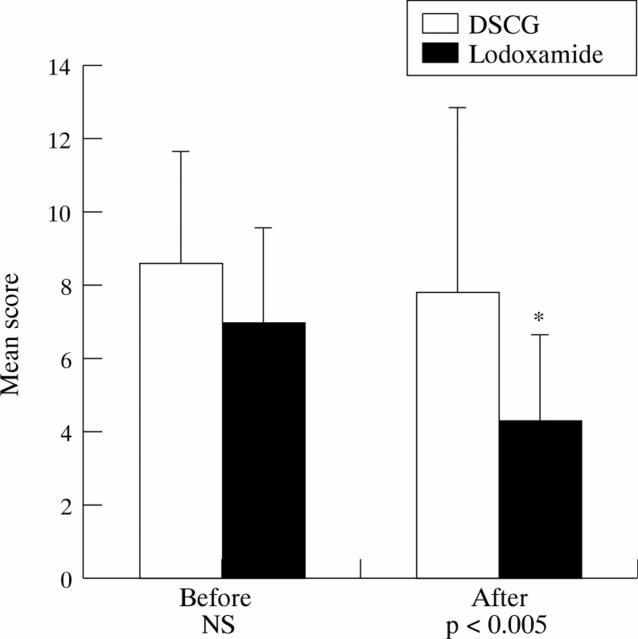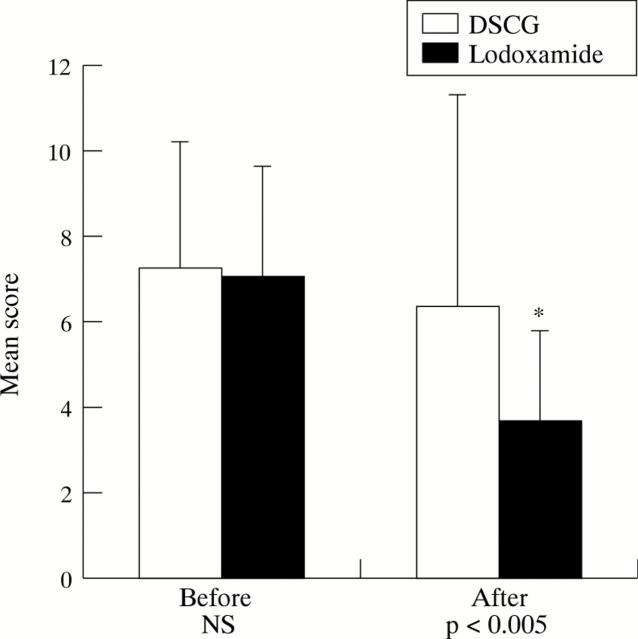Abstract
AIM—To validate the use of tear eosinophil cationic protein (ECP) as a marker for eosinophil activation, and its pharmacological modulation, in addition to evaluating the efficacy of lodoxamide and sodium cromoglycate in the treatment of vernal keratoconjunctivitis (VKC). METHODS—Tears were collected from 30 patients affected by active mild to moderate VKC before and after therapy with disodium cromoglycate 4% (DSCG) (n=15) or lodoxamide 0.1% (n=15) for 10 days. Tear cytology and ECP measurement were performed, and ocular signs and symptoms evaluated. RESULTS—While statistically significant changes did not occur after DSCG therapy, mean tear ECP increased from 343 (SD 363) µg/l to 571 (777) µg/l due to marked elevation in six eyes. The clinical score in DSCG eyes did not improve. After lodoxamide therapy, both clinical signs and symptoms, and tear ECP levels (560 (756) µg/l to 241 (376) µg/l) decreased significantly (p<0.0001 and p<0.01, respectively). Compared with DSCG treatment, lodoxamide was more effective in reducing signs and symptoms (p<0.005). ECP levels were significantly correlated with signs, symptoms, corneal involvement, and number of eosinophils in tears (p<0.0001). CONCLUSIONS—In patients with VKC, lodoxamide significantly reduced ECP tear levels, and thus, eosinophil activation, and was more effective than DSCG in reducing clinical signs and symptoms.
Full Text
The Full Text of this article is available as a PDF (98.7 KB).
Figure 1 .
Mean (SD) sum score of the six major ocular clinical signs of vernal keratoconjunctivitis (VKC) (conjunctival erythema, chemosis, discharge, papillae, limbus infiltrates, and epithelial disease) before and after topical, ocular treatment of 30 patients with VKC with either sodium cromoglycate 4% (DSCG) or lodoxamide 0.1%. *Statistically significantly lower than baseline ocular signs, p <0.005
Figure 2 .
Mean (SD) sum score of the four major ocular clinical symptoms of vernal keratoconjunctivitis (VKC) (itching, tearing, photophobia, and foreign body sensation) before and after topical ocular treatment of 30 patients with VKC with either sodium cromoglycate 4% (DSCG) or lodoxamide 0.1%. *Statistically significantly lower than baseline ocular symptoms, p <0.005.
Selected References
These references are in PubMed. This may not be the complete list of references from this article.
- Caldwell D. R., Verin P., Hartwich-Young R., Meyer S. M., Drake M. M. Efficacy and safety of lodoxamide 0.1% vs cromolyn sodium 4% in patients with vernal keratoconjunctivitis. Am J Ophthalmol. 1992 Jun 15;113(6):632–637. doi: 10.1016/s0002-9394(14)74786-5. [DOI] [PubMed] [Google Scholar]
- Easty D. L., Birkenshaw M., Merrett T., Merrett J., Entwhistle C., Amer B. Immunological investigations in vernal eye disease. Trans Ophthalmol Soc U K. 1980 Apr;100(Pt 1):98–107. [PubMed] [Google Scholar]
- Foster C. S., Duncan J. Randomized clinical trial of topically administered cromolyn sodium for vernal keratoconjunctivitis. Am J Ophthalmol. 1980 Aug;90(2):175–181. doi: 10.1016/s0002-9394(14)74850-0. [DOI] [PubMed] [Google Scholar]
- Leonardi A. A., Smith L. M., Fregona I. A., Salmaso M., Secchi A. G. Tear histamine and histaminase during the early (EPR) and late (LPR) phases of the allergic reaction and the effects of lodoxamide. Eur J Ophthalmol. 1996 Apr-Jun;6(2):106–112. doi: 10.1177/112067219600600202. [DOI] [PubMed] [Google Scholar]
- Leonardi A., Abatangelo G., Cortivo R., Secchi A. G. Collagen types I and III in giant papillae of vernal keratoconjunctivitis. Br J Ophthalmol. 1995 May;79(5):482–485. doi: 10.1136/bjo.79.5.482. [DOI] [PMC free article] [PubMed] [Google Scholar]
- Leonardi A., Borghesan F., Faggian D., Secchi A., Plebani M. Eosinophil cationic protein in tears of normal subjects and patients affected by vernal keratoconjunctivitis. Allergy. 1995 Jul;50(7):610–613. doi: 10.1111/j.1398-9995.1995.tb01209.x. [DOI] [PubMed] [Google Scholar]
- Olsson I., Venge P. Cationic proteins of human granulocytes. II. Separation of the cationic proteins of the granules of leukemic myeloid cells. Blood. 1974 Aug;44(2):235–246. [PubMed] [Google Scholar]
- Rak S., Löwhagen O., Venge P. The effect of immunotherapy on bronchial hyperresponsiveness and eosinophil cationic protein in pollen-allergic patients. J Allergy Clin Immunol. 1988 Sep;82(3 Pt 1):470–480. doi: 10.1016/0091-6749(88)90021-8. [DOI] [PubMed] [Google Scholar]
- Santos C. I., Huang A. J., Abelson M. B., Foster C. S., Friedlaender M., McCulley J. P. Efficacy of lodoxamide 0.1% ophthalmic solution in resolving corneal epitheliopathy associated with vernal keratoconjunctivitis. Am J Ophthalmol. 1994 Apr 15;117(4):488–497. doi: 10.1016/s0002-9394(14)70009-1. [DOI] [PubMed] [Google Scholar]
- Tomassini M., Magrini L., Bonini S., Lambiase A., Bonini S. Increased serum levels of eosinophil cationic protein and eosinophil-derived neurotoxin (protein X) in vernal keratoconjunctivitis. Ophthalmology. 1994 Nov;101(11):1808–1811. doi: 10.1016/s0161-6420(94)31097-9. [DOI] [PubMed] [Google Scholar]
- Trocme S. D., Aldave A. J. The eye and the eosinophil. Surv Ophthalmol. 1994 Nov-Dec;39(3):241–252. doi: 10.1016/0039-6257(94)90197-x. [DOI] [PubMed] [Google Scholar]
- Trocmé S. D., Kephart G. M., Bourne W. M., Buckley R. J., Gleich G. J. Eosinophil granule major basic protein deposition in corneal ulcers associated with vernal keratoconjunctivitis. Am J Ophthalmol. 1993 May 15;115(5):640–643. doi: 10.1016/s0002-9394(14)71463-1. [DOI] [PubMed] [Google Scholar]




